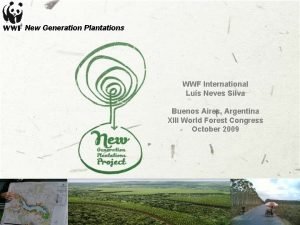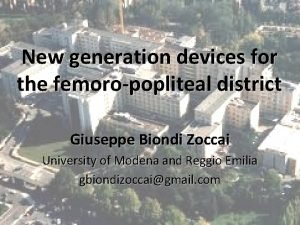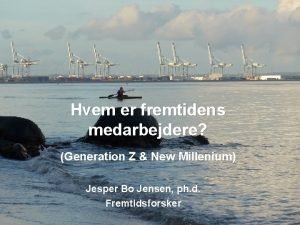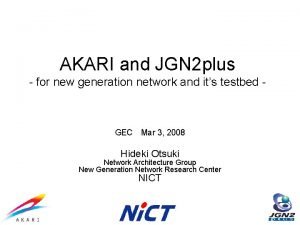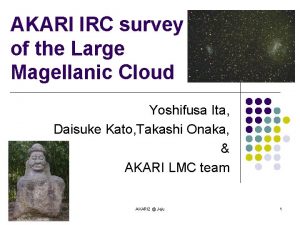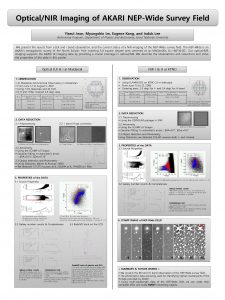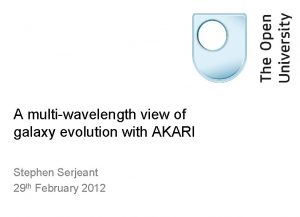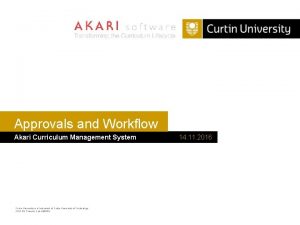AKARI Architecture Design Project for a New Generation










- Slides: 10

AKARI Architecture Design Project for a New Generation Network Future Network Architectures APAN/Joint Techs January 23, 2008 Masaki Hirabaru Network Architecture Group New Generation Network Research Center NICT (C) National Institute of Information and Communications Technology 1

What’s “New Generation Network” or NWGN? Examples: Next Generations New Generation Network (NWGN) Cell Phones > 2 G > 3 G > 4 G? Internet > IPv 4 > IPv 6 > IPv? Revised NXGN New Generations 1) clean-slate 2) modification Past Network Present Network 2005 Next Generation Network (NXGN) 2010 2015 AKARI … a small light in the dark pointing to the future (C) National Institute of Information and Communications Technology 2

AKARI Architecture Design Plan - Grand-Designing a New Generation Network beyond 2015 2006 2011 2016~ Innovation “AKARI Architecture Conceptual Design” released in April 2007. English version in Fall, 2007. Field Trial Prototyping JGN 2 plus Overlay Network Testbed Design Testbed Construction NWGN Blueprint Proof of Concept Design (Now) Concept & Principles 10+ Researchers (NAG) NWGN Workshop (Open) AKARI Camp (Invite Only) JGN X Service & Operations Standardization AKARI Architecture Homepage: http: //akari-project. nict. go. jp (C) National Institute of Information and Communications Technology 3

AKARI’s Current Focus: Network Architecture Role Safety & Security No vertical division. Common infrastructure Enjoy fundamental technology advances Ubiquity Energy-Saving Diversity Future requirements from diverse users and society Process Design Principles Network Architecture Select, integrate and simplify Evolving, future fundamental technologies proof Feedback -ofconcept Testbed (Overlay Network) All Optical Software Radio Theoretical Limits NETWORK SCIENCE Flexible to adopt a new user requirement Capacity (Peta) - Optimal Integration of many components - Stable enough to rely on for a long time - Grand-Designing a New Generation Network beyond 2015 (C) National Institute of Information and Communications Technology 4

AKARI Sustainable Architecture Principles Capacity for Quality 1. KISS (Keep It Simple, Stupid) • Crystal synthesis (select, integrate, simplify) • Common layer (layer degeneracy) • End-to-end (original Internet) 2. Reality Connection • ID-Locator separation • Bi-directional authentication • Traceability Reliable Network Space 3. Sustainable Evolution • • Self-* properties (emergent) Autonomic distributed control Scalable Social Selection For Future Diverse Society (C) National Institute of Information and Communications Technology 5

Power Spectrum AKARI Architecture Components (I) – Optical & Wireless (1) Parallel Optical Packet Transmission Header Payload Sustainable in Capacity Sustainable in Management and Capacity (3) PDMA (Packet Division Multiple Access) Wavelength … Wide Shared Channel #N #3 #2 #1 A, B, C, D E, F, G, H, I, J, K, L, M, N, O, P, Q, R, S, T (2) All-Optical Path / Packet Switching Forwarding table RE Sustainable in Usage delay OPS buffer delay Data m 1λ Control / Data cλ User a, b, c Look-up cλ m 2λ link n 1λ OCS Peta-bps switching capacity Tera-bps link speed (40 G x 100) 100 billion tiny terminals Energy Saving – All optical n 2λ User a, b, c Packet (CSMA/CA) Only Free from: Frequency Band Allocations Cell Design (4) ID / Locator Separation - Generic ID Space - Authenticated, but - Keep privacy Sustainable in Mobility & Security (C) National Institute of Information and Communications Technology Node Tag Hash Node Identifier ? + HIS name Node Name 6

AKARI Architecture Components (II) - New concepts (5) Overlay Network / Network Virtualization (6) Self-organizing Control Simultaneous Bad failures provisioning Chain Software reaction bug Efficient Robust Optimum Adapted Physical Networks Manageable Fast Recovery (C) National Institute of Information and Communications Technology 7

CORE: Collaborative Overlay Research Environment Private Overlay network over JGN 2, WIDE, and SINET Led by Prof. Aki Nakao Joint project with: CORE Concept Sapporo • 10 sites, 52 servers • Multi-Homed • Testbed Federation • JGN 2+ NOC Coop. Collaborative Overlay Research Environment Sapporo Medical U. Tohoku U. Hakusan Network Virtulization Lab. Sendai Hiroshima U. Kanazawa Kyutech NII Nagano Nagoya Kitakyushu Tokyo Features we would like to have… Custom hardware to optimize overlay forwarding Po. P/Core collocation (nodes “inside” network) Custom hardware to optimize overlay forwarding Wireless/Sensors/Photonic capability in future Federation (e. g. Planet. Lab, One. Lab) Target overlay research Not just on distributed system apps More on network core architectures Utilize both private & public environments Tsukuba Okayama Overlay test-bed based on “Private Planet. Lab” Provision resources for mission critical services U. Tokyo Local v. s. Global / Provisioned v. s. Best-Effort New Generation Perspectives to Overlay Network Osaka. Keihanna Fukuoka Kochi-tech Osaka U. NICT Koganei NICT Otemachi - Testbed for prototype and evaluate a new generation network design - Evolutional nature of overlay network to incorporate into the design (C) National Institute of Information and Communications Technology 8

AKARI NWGN (New Generation Network) R&D Plan 2006 07 08 09 10 11 12 13 14 15 Cooperative & Competitive Projects NWGN Community - Alternative Design - Network Security - Applications, etc. AKARI Architecture Design Overlay (Network Virtualization) Field Trials & Deployments Innovation Blueprint of NWGN Global Federated Facility JGN 2 Collaborative Projects CLEAN-SLATE APPROACH Social Requirements & Global Policy JGN 2+ JGN X (NWGN Testbed) Optical Packet Switch by NICT Cognitive Radio Photonic Network Phase I & II NGN Fundamental Technologies Dynamic Network Funded by NICT (C) National Institute of Information and Communications Technology 9

Questions? Universal Communications AKARI Architecture Design Project Members: Network Architecture Group Leader: Hirabaru Harai (Photonic switching), Xu (Light Path), Miyazawa (Opt. Access), Morioka (Optical Transmission), Ohtsuki (Control), Jumpot, Inoue (Univ. Access), Nakauchi (Overlay), Kafle (Addressing), and Ohnish i. Network science by Prof. Murata (Osaka U. ) Ubiquitous by Prof. Morikawa (U. Tokyo) Mobility by Prof. Teraoka (Keio U. ) Packet switching by Prof. Ohta (Tokyo Inst. Tech. ) Network Virtualization by Prof. Aki Nakao (Univ. of Tokyo) Advisory: Program Director Prof. Aoyama, Executive Director Dr. Kubota (C) National Institute of Information and Communications Technology 10








